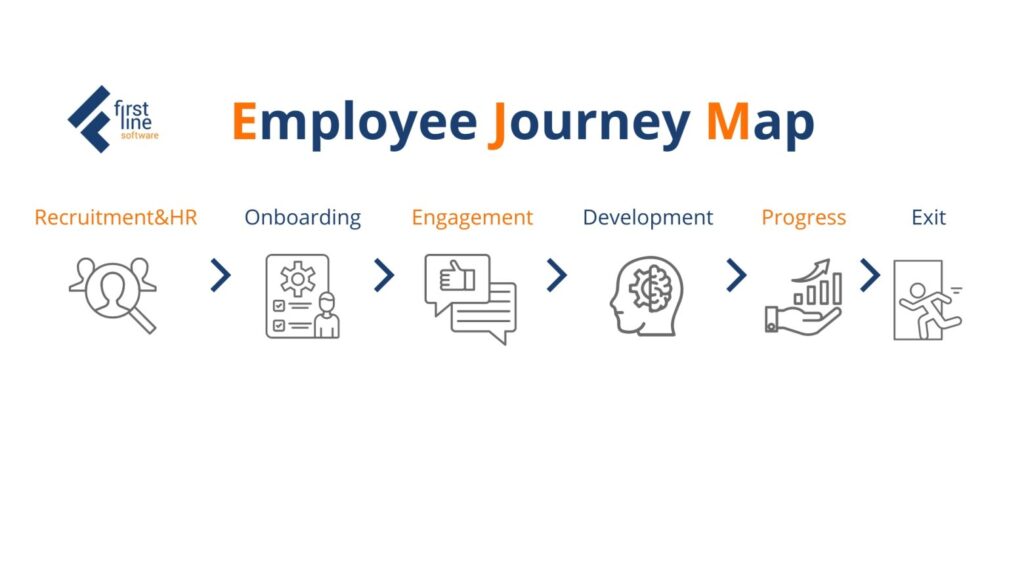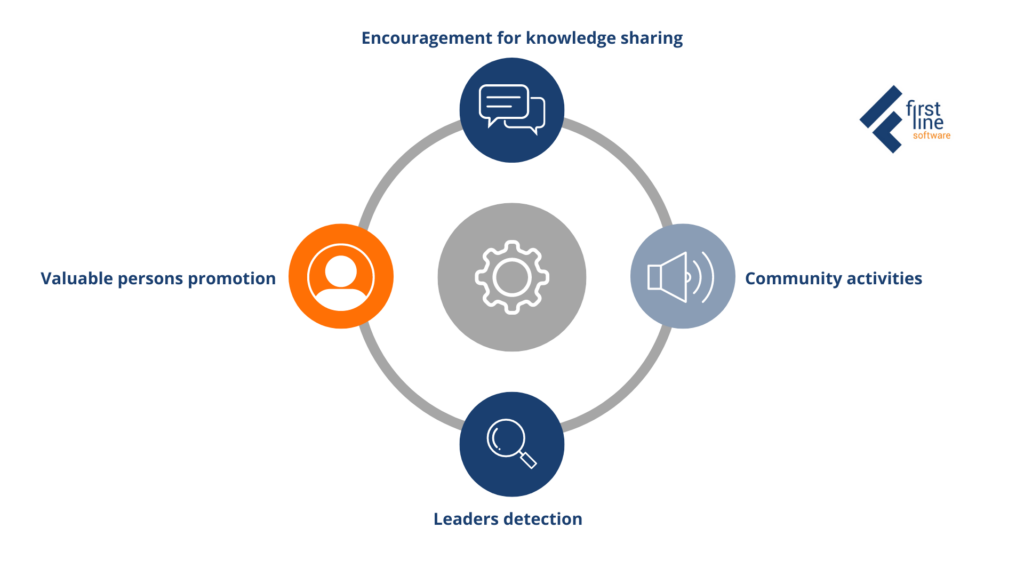What is EXP and Why Does it Matter?

Customer Experience, Digital Experience, User Experience – All buzzwords we’ve been constantly hearing in today’s world. Companies put lots of effort into working through every touchpoint between the business and their customers. But aren’t we missing something here? Employee Experience or EXP stays out of the radar. Internal communications are not considered in the context of sales and customer interaction. In this article we’ll explain what EXP is, why you should care and what technologies can help you implement your own Employee Experience program.
What is EXP and how does it affect CX?
Employee experience is the journey that people in your teams go through within your organization. This is what they experience and what they observe while working with your company.
Business is always about communication and interaction. And your customers do communicate with your employees. As in the case when it is direct – with administrative staff, sales, support team or project manager. And indirectly – interacting with the products that your employees create.
Every employee in some way is the face of your company. They reprepresent it to the outside world through conversations with potential buyers, through the work they do and the way they talk about it, even through their own social networks.
If these employees feel unhappy, if they don’t feel involved in the company, don’t understand and don’t share its values, and aren’t interested in business growth – at best, they will not do worse. But all this will definitely affect both communication with clients and the quality of work that they will perform for you. And what’s most important? Your customers will notice these things as well, even if they can’t always explain what they’re noticing… they’ll ultimately leave for your competitors.
How to improve the Employee Experience
So how can you improve your employee experience within the company? Start from understanding the current situation and begin outlining your Employee Journey Map (EJM) by including this steps:
- Recruitment
- Onboarding
- Engagement
- Development
- Progress
- Exit

Think of the touchpoints on each of the six steps and their possible improvements. From here we’ll give you some great examples from our own practice on how a combination of HR and IT can raise the bars for your EXP and help with the following:
- Social Selling Support
- Engagement for distributed teams
- Recruitment of the right people
.
Social Selling Support with EXP
One cannot but agree that social selling has firmly taken its place among the effective sales strategies in 2023. In a world teeming with dehumanized marketing communications, it is no longer enough for you to make a website and run a few advertising campaigns on Google Ads. Business is always about communication and interaction. Consumers want to see the people they will interact with and buy from.
There’s a direct correlation between closed deals and social selling tactics. 54% of survey respondents have associated closed deals with their engagement on social media
Social Media and Sales Quota Survey
But in order to make your social selling work, you need people. Employees who are able and willing to share their expertise and demonstrate that your company has this expertise and knowledge. You need to find these people, raise them, support them and show them how to do it.
Social selling is a completely new type of selling through qualification and successful interaction with clients. This is especially true for service companies. Each employee who talks about his expertise or the work that he performs can be the starting point from where your dialogue with the client begins.
How can HR support social selling?
The HR department is a place where knowledge about the people who work in the company is accumulated and distributed. The HR team knows your employees and builds communication between the company and its workers.
Within this internal communication you can start to support knowledge sharing. Show it as a value of your company. Inspire your people to share expertise and build a community.
You need to find those employees who can become leaders in this direction. Those who will be ready to represent your company not only internally, but externally as well.

As a company leader, you need to understand how you can help employees and how collaborating within the company can boost your social selling. Perhaps your staff needs the help of outside experts from other fields to create the valuable materials that you might be lacking. This might include the help of experienced content writers to work on texts, or social media professionals for more dynamic content. Maybe they’re ready to start making a podcast or a video of their expertise, but don’t know how to get it produced. Find out what they need and support them.
How can technologies help HR?
- Educate yourself and HR leaders on management solutions and wikis – There are entire industries with supportive solutions to educate your people. Give them a portal to hone their teaching skills so others can learn from their expertise and continue to pass on skills.
- A Headless CMS approach – Utilize one place for expert content generation with different destinations and views. This can be used throughout your internal communications portal with cross-posting solutions to enable sharing content on social media and other channels that you use for your marketing.
Learn more!
On-Demand Webinar “Enhancing Talent Acquisition Process: Best Online Practices”
Engagement for distributed teams
The Covid era has forced big adjustments to our understanding of everyday life, including our work. Distributed teams have become the norm and remote workers are now part of almost every team. This opens up great opportunities in terms of recruitment – you are no longer limited by your location when selecting a specialist. The right expert can be located anywhere in the world and you can readily fold them into your team. But the same remoteness brings challenges for HR t in creating employee engagement.
Engagement is one of the most important aspects of motivation. It’s essential that the people who work for you don’t see it as a dull job. Money and benefits can be a motivation, but such motivation does not ultimately last in the long term. Consequently – feeling like a part of a team, having a desire to grow and progress together, understanding the straight path between your success and the success of your company – is the motivation that will allow you to get an exponentially higher level of work performed by employees.
When we don’t have to go to the same office, don’t go to lunch together or have water cooler chats, it’s much more difficult to feel like a part of an organization. It becomes much more difficult to understand who is doing what and to see what the company is striving for. Just as our daily meetings and communications may have moved online, the HR team’s employee engagement activities must also move online to be accessible to all employees, whether they go to the office, work from home in another country, or combine office and remote work.
How can technologies help bring employees together?
Here are just a few examples of how you can use technology for engagement and retention policies:
- Coworking spaces – If you have employees with home-offices and want to keep personal contact between them for meetings, meetups, etc. the scenario here is to use a web application for booking a coworking space for those who can’t work from home or want to personally meet with colleagues. With authorization and a visual map with the available spaces on site you’ll make this process simpler for everyone.
- Time tracking solutions – If you have a distributed team and want to track their activities, use web applications which help to track all the teams activities or tasks and can generate monthly reports.
- Corporate portals – “Oldies but Goodies”, can still be the main entry point for the interaction between employees and the company and it’s services
- Internal communication and events supporting solutions – landings or applications for corporate events, contests, and common social activities also make real sense.
Recruitment of the right people
The right candidates are the ones worth fighting for. How do people choose a company to work for? They compare different offers with salaries, bonuses, the life of the company, and its overall reputation.
Money and benefits are certainly important, but in general they are about equal across your direct competitors. However, you probably cannot compete with very large players in your field. What remains? An experience you can offer to your employees and the path you build for them while nurturing their growth within your organization.
Social selling, which we talked about earlier, can “sell” your company not only to potential clients, but also to candidates. If your potential employees see that people working for your company have expertise they desire,and can help them grow and develop – they’ll want to work for you.
You need to know and understand what else is important for your employees at work. What they value and want to see while they work with you. And you need to present this to potential candidates in an accessible and visual way. This will ensure that the best candidates understand the value of your offer and will strive to work hard in your company.
How can technologies help with recruitment?
- Recruitment automation in Jira – This helps building and automating the hiring process using the Atlassian Jira tool. The tool allows for customizing, configuring and the building of smart staffing reports
- An idea factory – Is a platform where employees can contribute ideas regarding improvements to the company and the services it provides. It helps you understand what your employees value and helps you both feel more involved in the company.
- A contest portal – Can be part of an internal employee motivation program that allows participants to use points accumulated in the process of participating in corporate activities for prizes, vacation time, etc.
- A data-driven career site – Is effective in understanding conversions, metrics and analytics for regions, age groups, and traffic sources. It will also help you to look better online and aid you in the use of modern marketing technologies for your recruitment process.
What’s next in your EXP journey?
As you can see, the combination of HR and IT can add a lot to the experience of your employees. These examples are just some of the ways you can apply technology solutions to make your employee touch points more interactive and meaningful.
It’s most important to remember that each employee is a representative of your company. They all help you run the business, grow sales, and attract new specialists to the team. Much of this all happens through the presentation of their expertise to the outside, and internally to other employees.
Therefore, your people are your most valuable resource. Taking care of their experience is one of the most important tasks you have as a business owner or leader.
Help them grow, help them get involved and feel like part of a bigger cause, help them go out into the world with their knowledge, and very soon you’ll see how your CX begins to improve through EXP.
Let’s discuss your EXP goals
Examples of the use of technologies in this article are real-world solutions from the practice of First Line Software both internally and for our clients.
If you would like to learn more about these solutions, or to discuss your technology ideas for your business please contact us. Our experts are always ready to help you achieve your goals and help solve any issues with EXP. Let’s talk today!
